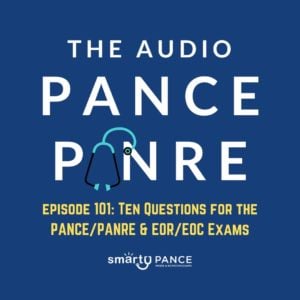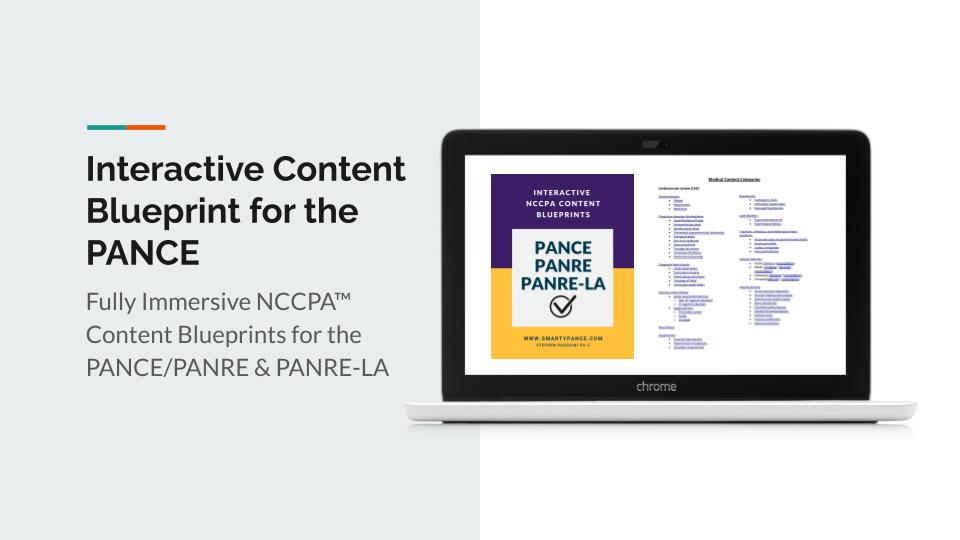Podcast: Play in new window | Download
Subscribe: Apple Podcasts | RSS
 Welcome to episode 101 of the Audio PANCE and PANRE Physician Assistant/Associate Board Review Podcast.
Welcome to episode 101 of the Audio PANCE and PANRE Physician Assistant/Associate Board Review Podcast.
Join me today as we cover ten board review questions for your PANCE, PANRE, and rotation exams.
Special from today’s episode:
- Join the Smarty PANCE Member’s Community then sign up for a study group to get updates about upcoming webinars.
- Check out our updated End of Curriculum™ (EOC) Exam Course
- Sign up for the Entire Blueprint Email Series
- Follow Smarty PANCE and The Daily PANCE Blueprint on Instagram
- Follow Smarty PANCE and The Daily PANCE Blueprint on Facebook
I hope you enjoy this free audio component of the examination portion of the Smarty PANCE website. The full board review website includes over 2,000 interactive board review questions, flashcards, and blueprint lessons available to all members of Smarty PANCE.
- You can download and listen to past FREE episodes here, on iTunes, Spotify, Google Podcasts, Stitcher, and most podcasting apps.
- You can listen to all the latest episodes, take interactive quizzes, and download more resources on each episode page.
Listen to Podcast Episode 101: Ten PANCE, PANRE, and Rotation Review Questions
If you can’t see the audio player, click here to listen to the full episode.
Interactive exam to complement today’s podcast
1. A 75-year-female smoker with a history of atrial fibrillation and hypertension presents to the ER complaining of a 2-hour history of right-sided weakness and aphasia that has now resolved. Her physical exam and vital signs are completely unremarkable. CT head is unremarkable. Which of the following is the most likely diagnosis?
A. Subarachnoid hemorrhage
B. Transient ischemic attack
C. Cerebral venous sinus thrombosis
D. Multiple sclerosis
E. Complicated migraine
2. A 26-year-old female presents with a history of miscarriages and recurrent pulmonary embolism. She is diagnosed with antiphospholipid syndrome. Which of the following is the mainstay of treatment for this condition?
A. Dual antiplatelet therapy (DAPT)
B. Aspirin and heparin
C. Dabigatran
D. Warfarin
E. Heparin
3. Which of the following is the most common cause of acute bronchitis in the United States?
A. Virus
B. Bacteria
C. Fungus
D. Allergies
E. Tuberculosis
4. A 27-year-old male presents to the clinic with shortness of breath, chest pain, and fatigue. His physical exam is remarkable for a crescendo-decrescendo systolic murmur heard at the apex. An echocardiogram reveals asymmetric septal hypertrophy and left ventricular hypertrophy. Which of the following is the best initial treatment option?
A. Procainamide
B. Hydrochlorothiazide
C. Beta-blockers
D. Aspirin
E. ACE inhibitor
5. A 22-year-old female presents to the ER with crampy lower abdominal pain and vaginal bleeding for the past 2 hours. She missed her last menstrual cycle. The physical exam is remarkable for an open cervical os. No products of conception are observed. Which of the following is the most likely diagnosis?
A. Threatened abortion
B. Incomplete abortion
C. Missed abortion
D. Septic abortion
E. Inevitable abortion
6. Which of the following is not a risk factor for Methicillin-resistant Staphylococcus aureus (MRSA)?
A. Previous antibiotic use
B. Injection drug use
C. Indwelling hemodialysis catheter
D. Presence in long-term facility
E. All of the above are risk factors
7. A 60-year-old male presents with fatigue and weight loss. His physical exam is remarkable for gingival hyperplasia and splenomegaly. Labs reveal pancytopenia. A bone marrow biopsy reveals Auer rods. What is the likely diagnosis?
A. Acute myeloid leukemia
B. Acute lymphocytic leukemia
C. Chronic myeloid leukemia
D. Chronic lymphocytic leukemia
E. Non-Hodgkin’s lymphoma
8. Giant Cell Arteritis: The Daily PANCE Blueprint
A 55-year-old female presents with right-sided headaches, jaw pain upon chewing, and mild dizziness for the past few months. On physical exam, the right temporal artery is tender to palpation. Labs reveal an elevated ESR and CRP. What is the definitive diagnosis for this condition?
A. CT head
B. Temporal artery biopsy
C. PET scan
D. Ultrasound
E. IgA antibody level
9. Which of the following is one of the most common initial clinical symptoms in multiple sclerosis?
A. Vertigo
B. Extreme weakness
C. Depression
D. Arthralgias
E. Optic neuritis
10. A 52-year-old male presents to the clinic complaining of “sharp burning” in his lower chest after eating a large meal. The pain goes away when he raises the head of the bed. Which of the following is the best pharmacological agent for this likely diagnosis?
A. Esomeprazole
B. Nitroglycerin
C. Aspirin
D. Codeine
E. Sucralfate
This podcast is available on every device!
You can download and listen to past FREE episodes here, on iTunes, Spotify, Google Podcasts, Stitcher, Amazon Music, and all podcasting apps.
Download Interactive Content Blueprint Checklists for the PANCE, PANRE, EOR, and PANRE-LA
Follow this link to download your FREE copy of the PANCE/PANRE/EOR Content Blueprint Checklists.
Print it up and start crossing out the topics you understand, marking the ones you don’t, and making notes of key terms you should remember. The PDF version is interactive and linked directly to the individual lessons on Smarty PANCE.

